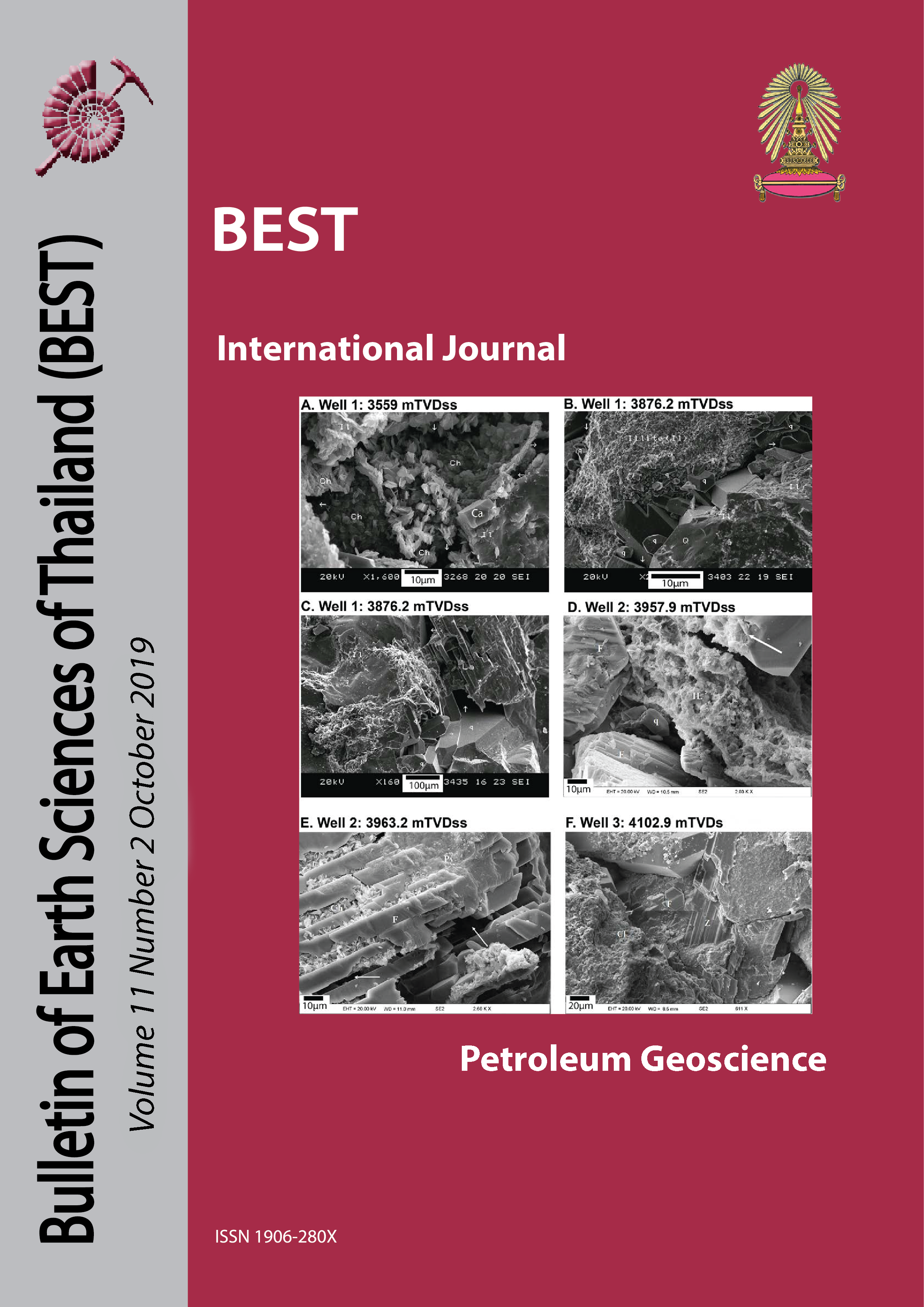Diagenetic Evolution and Isotopic Characteristics of a Clast Breccia Reservoir in Nang Nuan Field, Chumphon Basin, Gulf of Thailand
Main Article Content
Abstract
Hydrothermal karst in the Pre-Tertiary Ratburi limestone plays a significant role in the formation of reservoir in the Nang Nuan oil field, offshore Thailand. Hydrothermal karstification is considered the most likely mechanism to explain reservoir geology in the Nang Nuan field, (Heward et al., 2000). However, the exact controls on the reservoir properties and the style of hydrothermal alteration or diagenetic evolution are still uncertain.
This research focuses on subsurface data from Nang Nuan wells and generates a carbon-oxygen isotope set of plotfields to identify the effects of ongoing diagenesis in fracture fills and the breccia matrix. Distinctive features of the breccias are documented and defined using rock textures and then integrated with thin section microscopy, stable isotope signatures and XRD determinations. Drilled cores and cuttings from 4 wells are selected for isotopic analysis and classified by lithology into 6 groups to differentiate diagenetic events in the Nang Nuan field.
Isotopic characteristics of diagenetic features in Nang Nuan field show two main trends: one follows a regional burial trend for the Ratburi limestone, similar to the burial trend seen in reservoir carbonates in Sinphuhom field in NE Thailand; the other trend implies a separate mixing trend. There are mixing trends in both Nang Nuan and Sinphuhom fields defined by significant decreases in δ13CPDB values that relate to deeply-circulating telogenetic fluids. But the δ18OPDB value range is different in Nang Nuan as it shows a vertical trend tied to increasing negative carbon values, with a limited and hotter temperature range in its oxygen values compared to Sinphuhom. Sinphuhom reservoir carbonates show a downward sloping trend tied to decreasing negative oxygen values that are related to exposure to ongoing shallower and cooler fluid crossflows that in turn tie to uplift and increasingly shallow meteoric waters. The difference in mixing trend between the two fields implies Nang Nuan experienced a shorter deeper (warmer) fluid event that would have allowed further porosity loss after the porosity-enhancing hydrothermal event. The differences in telogenetic fluid styles mean that Nang Nuan field will perhaps show lower proportions of connected permeability needed to allow lateral crossflows of reservoir fluids between matrix and veins, compared to Sinphuhom field.
Article Details

This work is licensed under a Creative Commons Attribution-NonCommercial-NoDerivatives 4.0 International License.
Copyright © 2008 Department of Geology, Faculty of Science, Chulalongkorn University. Parts of an article can be photocopied or reproduced without prior written permission from the author(s), but due acknowledgments should be stated or cited accordingly.
References
Baird, A., and Bosence, D., 1993, The sedimentological and diagenetic evolution of the Ratburi Limestone, Peninsular Thailand: Journal of Southeast Asian Earth Sciences, v. 8, nos. 1-4, p. 173-180.
Clews, P., 2010, PTTEP Internal Core Description and Sedimentology of Nang Nuan Field.: PTTEP internal report, p.918.
Cuong, T. X., and Warren, J. K., 2009, Bach Ho Field, A Fractured Granitic Basement Reservoir, Cuu Long Basin, Offshore SE Vietnam: A “Buried-Hill” Play: Journal of Petroleum Geology, Vol. 32(2), p.129-156.
C&C Reservoirs, 2019, Nang Nuan field, Ratburi Carbonates and Lower Tertiary Conglomerates Reservoirs, Chumphon Basin, Thailand, p.15-27
Davies, G. R., and L. B. Smith, 2006, Structurally controlled hydrothermal dolomite reservoir facies: An overview: Bulletin American Association Petroleum Geologists, v. 90, p. 16411690.
DMF, 2007, Thailand petroleum province: Department of Mineral Fuels, http://www.dmf.go.th/bid20/petro_prov ince.html, 10 p. (last accessed June, 21 2018).
Heward, A.P., Chuenbunchom, S., Makel, G., Marshland, D. and Spring, L., 2000,
Nang Nuan oil field, B6/27, Gulf of Thailand: karst reservoirs of meteoric or deep-burial origin?, Petroleum Geoscience, Vol.6, p.15-27
How, N., 2017, Facies Nature and Relative Timing of Burial and Deformation of Sediments and Metasediments South of the Indosinian Suture, Ratchaburi Thailand: Implications for Fractured Basement Potential.: MSc thesis, Chulalongkorn University, Bangkok.
Katz, D.A., et al, 2006, Tectonic Hydrothermal Brecciation associated with calcite precipitation and permeability destruction in Mississippian carbonate reservoir, Montana and Wyoming: The American Association of Petroleum Geologists, v.90, No. 11, p. 1803 – 1841.
Lawwongngam, K., and Philip, R.P., 1993, Preliminary investigation of oil and source rock organic geochemistry from selected Tertiary basins of Thailand: Journal of Southeast Asian Earth Sciences, v. 8, nos. 1-4, p. 433-448.
Lousuwan, K., 2005, Hydrothermal karst in the Nang Nuan oil field, Gulf of Thailand.: MSc thesis, University Brunei Darussalam, Brunei.
Morley, C.K., and Racey, A., 2011, Tertiary stratigraphy, in Ridd, M.F., Barber, A.J., and Crow, M.J., eds., The geology of Thailand: The Geological Society, London, p. 223-372.
Nelson, C. S., 1996, Stable oxygen and carbon isotope compositional fields for skeletal and diagenetic components in New Zealand Cenozoic nontropical carbonate sediments and limestones: a synthesis and review.: New Zealand Journal of Geology and Geophysics, 1996, Vol. 39, p. 93-107.
Panthong, A., 2015, Facies distribution and diagenetic evolution of a carbonate reservoir in Pha Nok Khao Formation, Sinphuhorm field, Thailand.: MSc thesis, Chulalongkorn University, Bangkok.
Piggot, J.D., and Sattayarak, N., 1993, Aspects of sedimentary basin evolution assessed through tectonic subsidence analysis. Example: northern Gulf of Thailand: Journal of Southeast Asian Earth Sciences, v. 8, nos. 1-4, p. 407-420.
Racey, A., 2011, Petroleum geology, in Ridd, M.F., Barber, A.J., and Crow, M.J., eds., The Geology of Thailand: The Geological Society, London, p. 351-392.
Ridd, M.F., Barber, A.J., and Crow, M.J., 2011, Introduction to the geology of Thailand, in Ridd, M.F., Barber, A.J., and Crow, M.J., eds., The geology of Thailand: Geological Society of London, p. 1-17.
Warren, J. K., C. Morley, T. Charoentitirat, I. Cartwright, P.Ampaiwan, P. Khositchaisri, M. Mirzaloo, and J. Yingyuen, 2014, Structural and fluid evolution of Saraburi Group sedimentary carbonates, central Thailand: A tectonically driven fluid system: Marine and Petroleum Geology, v. 55, p. 100121.
Wilson, M. E. J., M. J. Evans, N. H. Oxtoby, D. S. Nas, T. Donnelly, and M. Thirlwall, 2007, Reservoir quality, textural evolution, and origin of fault-associated dolomites: Bulletin American Association Petroleum Geologists, v. 91, p. 1247-1272.


